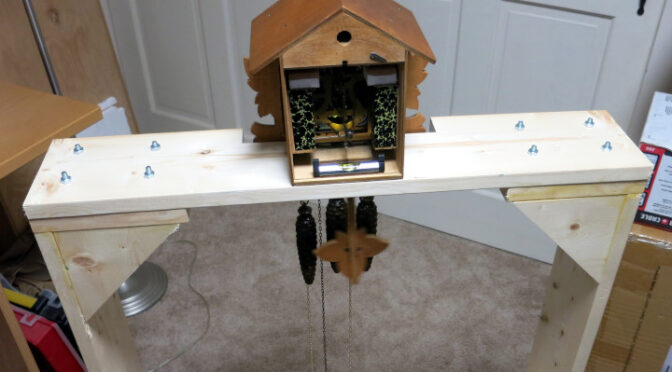
I’m repairing a cuckoo clock that has a commonly-seen problem: one of the screws mounting the movement to the case has stripped its hole. Normally, I’d try filling the hole with a wood filler, but this time I tried something different: “Bushing” the hole with a plug of new wood.
In digging around for clock case repair advice, I found a wonderful book, Extreme Restoration by T.E. Temple, which covers many clock case restoration methods. Its section on repairing stripped nail and wood screw holes in clock cases inspired me to try using a wood plug to patch the stripped hole, because that author has found wood plugs to be an excellent long-term repair.
Continue reading Repairing a Clock Case’s Stripped Wood Screw Hole →

While repairing the latest musical cuckoo clock I discovered a problem in the musical movement: a cracked plastic gear. I was at a loss as to how this could be fixed, but once again found the solution from expert posts on the message boards at the NAWCC (National Association of Watch and Clock Collectors). The whole story follows…
Continue reading Repairing a Cracked Plastic Clock Gear →

The family cuckoo clock I’m working on is being capricious about when it decides to play the music, so I’ve built a test stand that will let me see what’s going wrong.
After looking through the wide variety of weight-driven clock test stands on NAWCC.org. I decided to build a floor-standing U-frame.
TL;DR: There are links to rough drawings of my completed plans at the end of this post, so you have something to start your own design from.
Continue reading Building a Cuckoo Clock Test Stand →

Once I had the eBay cuckoo clock cleaned, adjusted, repaired, and running, I put the hands on. To my surprise, the minute hand kept slipping, no matter how I tightened the hand nut that’s supposed to hold it in place. The solution to this mystery lay in a troubleshooting video from a cuckoo clock seller in the Black Forest.
Continue reading Problems Adjusting the Cuckoo Minute Hand →

A while ago I bought a beat up cuckoo clock on eBay, to practice cuckoo clock cleaning and repair. Its face was missing most of its numerals. In this post, I describe how to use a 3D printed template to glue the numerals on a cuckoo clock’s face.
Continue reading Replacing the Numbers on a Cuckoo Clock Dial →

An older clock has usually spent years in the company of a smoker or near a smokey fireplace, accumulating layers of tar, ash, and who knows what else. A simple dusting or cleaning with a wood polish won’t necessarily remove these layers of smoke, so when it’s time to clean a vintage clock, it doesn’t hurt to clean the case as well.
Continue reading Cleaning the Cuckoo Clock Case and Figures →

I’m in the process of cleaning and repairing a family musical cuckoo clock. I’ve watched a lot of videos on repairing cuckoo clocks, and have disassembled, cleaned, and repaired one cuckoo movement, so I think I’m as prepared as I can be for working on the clock movement.
The musical movement is another matter. What follows is a detailed How To that captures what I learned, what to do, and what not to do.
Continue reading Cleaning and Adjusting a Cuckoo Clock’s Musical Movement →

Because of the economics of cuckoo clock repair, you can easily find old, dirty cuckoo clock movements on eBay for a fraction of what a new movement costs. These movements come with no documentation, so you get to work out which chains, weights, and bellows (cuckoo whistles) are right for them.
In this post I calculate the run time (1 day vs. 8 day) of a cuckoo movement I recently bought, and the Links Per Foot of the chain it uses. These two numbers tell me what parts to buy to make a clock case for this movement.
Continue reading Is That Cuckoo a 1-Day or an 8-Day Clock? →
Technical Writing and Self-Pubilshing








